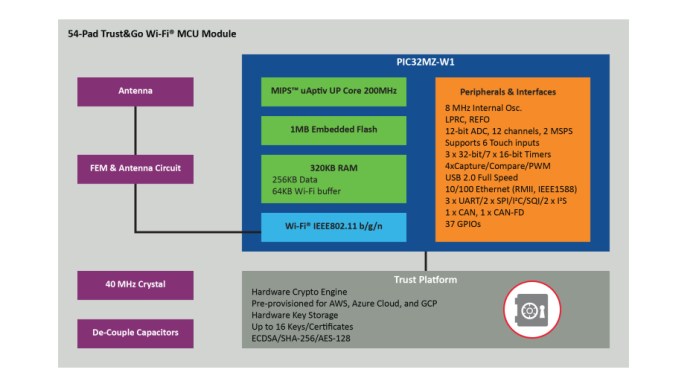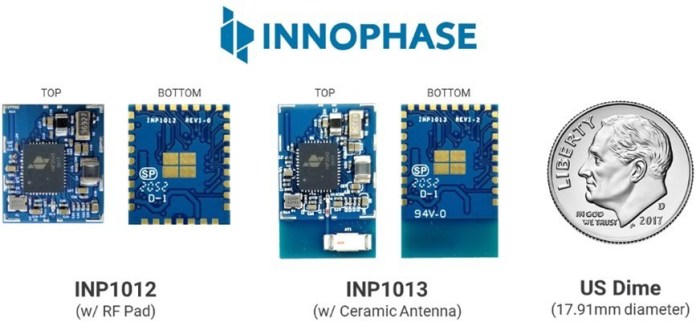A key piece of the IoT system design puzzle is solving the big technical challenges around wireless development design. This is where wireless microcontroller (MCU) modules can simplify design by providing all of the matching circuits along with security, connectivity, and pre-certifications, bundled in one device. In addition, these wireless MCU embedded module manufacturers provide hardware reference designs that can lower design risk, improve time to market, and shorten the design cycle.
A growing driver for these highly integrated modules with secure connectivity is home control, along with industrial automation. In either application, these highly integrated modules are becoming technical and time savers for many IoT designers, so they don’t have to worry about a lot of challenges around wireless development, including RF. Two of the biggest benefits include reducing the hardware development work and simplifying connectivity design.
Wireless modules provide a wide range of processing functionality and connectivity options (Wi-Fi, Bluetooth, LoRa, Zigbee, etc.) required for the different connected devices. So designers need to consider several key features, such as processing performance, protocol support, interfaces, certifications, and security features before selecting the module.
Developers of IoT systems are also looking for solutions that are pre-provisioned for the cloud to further ease product development. One example is Microchip Technology’s WFI32E01PC Trust&GO platform-enabled Wi-Fi MCU module that incorporates a powerful MCU with verifiable identity.
The WFI32E01PC module streamlines the process of network authentication using secure element technology, which is preconfigured and pre-provisioned for cloud authentication. This makes it a lot easier for developers who are designing secure industrial IoT systems. The module can also be used in home automation devices, computing, and consumer devices.
The WFI32E01PC is Microchip’s first Wi-Fi MCU module with the company’s Trust&GO-enabled verifiable identity. The integrated solution, featuring a premium PIC32 MCU core and advanced peripherals, provides industrial-grade MCU functionality, Wi-Fi connection, and hardware security and authentication while improving RF power and providing a higher level of security.
The new “all in one” module addresses the challenge of system-level support when using various chips from different vendors, said Microchip.
The WFI32E01 module can be paired with other Microchip components — such as the KSZ8081 family of Ethernet PHYs or the MCP2542WFD family of CAN transceivers, sensors, and radio technologies including Bluetooth Low Energy (BLE), LoRa, and IEEE 802.15.4 — for a total solution.
The WFI32E01PC is compliant to the Wi-Fi Alliance (WFA) specification and fully certified with the following world regulatory agencies: Federal Communications Commission (FCC), Industry Canada (IC), and European Radio Equipment Directive (RED).
Other ease of implementation features include the PIC32MZW1 Curiosity Board, which is qualified with AWS IoT Core and is listed in the Amazon Web Services (AWS) Partner Device Catalog. It contains an out-of-box demo, featuring registration and communication with AWS IoT Core and interaction with the on-board sensors using Alexa Voice Service. The AWS IoT Core qualification includes code samples, WLAN software, and network stack, which can be found in MPLAB Harmony v3.
Microchip offers several options for software support, including the MPLAB X integrated development environment (IDE) and MPLAB Harmony v3 embedded software development framework. Supporting tools include the on-board debugger and in-circuit serial programming header for MPLAB Snap, MPLAB PICkit 4, or MPLAB ICD 4 external programmer/debuggers.

Microchip’s WFI32E01PC Trust&GO platform-enabled Wi-Fi MCU module features a premium PIC32 MCU core, advanced peripherals, Wi-Fi connectivity, and hardware security and authentication. (Source: Microchip Technology)
Another design saver is the STM32 wireless MCU module from STMicroelectronics. This is the company’s first STM32 wireless MCU module, which offloads the complete RF design for IoT systems, delivering a faster time to market. STMicroelectronics said the module accelerates the design of new BLE- and 802.15.4-based IoT devices without needing wireless-design skills. Housed in a 7 × 11.3-mm package, the miniature, ready-to-use STM32 wireless MCU module integrates everything up to the antenna.
The module supports ST’s novel concurrent dual-protocol mode that lets any protocol based on IEEE 802.15.4 radio technology, including Zigbee 3.0 and OpenThread, connect the user directly to any BLE device, said the company. It also meets FCC, CE, JRF, KC, SRRC1, and GOST geographical certifications.
The wireless MCU module integrates a miniature antenna matched to the receiver circuitry, built-in switched-mode power supply solutions, and frequency-control components. It supports crystal-less USB full-speed connectivity for a simpler hardware design and lower bill-of-materials costs.
Also providing high performance, the MCU module includes all of the features of ST’s STM32WB55 ultra-low–power wireless microcontrollers. It can be used in a variety of applications, including smart-home, smart-building, and smart-factory equipment. These features include the MCU’s dual-core architecture that separates radio and application-level processing, large memories for radio and application code and data storage, and cybersecurity.
Cybersecurity features include over-the-air secure software updates for brand protection and device integrity, customer key storage and proprietary code readout protection to protect developers’ intellectual property, and public key authentication support for cryptographic protection of code and connections, said ST.
The module enables designers to develop a simple, low-cost PCB using the module’s optimized pin-out. Designers can speed up their product development by using the tools, design wizards, radio stacks, and turnkey software libraries of ST’s STM32Cube MCU development ecosystem, available free of charge. ST also created a dedicated application note as extra guidance for module users.
Also promising greater design flexibility and high integration are the Talaria TWO INP1012 and INP1013 modules from InnoPhase, a fabless semiconductor company. These miniaturized Wi-Fi and BLE wireless modules target a range of products including smart-home, smart-industrial, and smart-health applications. Combining wireless connectivity and an integrated microcontroller, the platform is well suited for edge-of-network IoT devices that require low power consumption and a direct-to-cloud connection. These include smart door locks, remote security cameras, connected sensors, or other space-constrained products within home, commercial, industrial, and health markets.
The miniaturized modules are 40% smaller than the original INP1010/INP1011 modules, the RF category winner of Electronic Products 2020 Product of the Year. InnoPhase’s modules incorporate PolaRFusion, a digitally intensive radio architecture that significantly reduces the amount of power required to transmit, process, and receive wireless information using industry-standard wireless protocols. The PolaRFusion architecture moves much of the radio-signal processing from power-hungry analog circuits into highly efficient digital logic, said the company.
The smaller INP1012 and INP1013 modules embed the Talaria TWO multi-protocol system-on-chip (SoC), leveraging its processing capability, ultra-low–power wireless connectivity, and robust security. Typical smart IoT applications can use as much as 75% of the overall system power for Wi-Fi connectivity, even while idly connected to the network, said InnoPhase. The INP1012/1013 can increase battery lifetime by months or years while requiring less space.
The integrated, multi-protocol modules include Wi-Fi and BLE5-Long Range for wireless data transfer, an embedded Arm Cortex-M3 for system control and user applications, and advanced security elements. Hardware-based security includes physically unclonable function, crypto engines, and secure boot. It also integrates 512-KB SRAM and 2-MB flash of embedded memory. In addition, the INP1012 module allows the user to select the antenna connection and placement, which is a benefit for industrial applications.
The modules can operate in standalone mode, in conjunction with an external MCU, or in a hybrid mode in which system control and processing are shared between the module and an external MCU, explained the company. The functional modes are: hosted mode (with external MCU), hostless mode (without external MCU), or hybrid mode (low-power system monitoring and wakeup on the Talaria TWO MCU, higher-power processing on an external MCU/GPU).
The modules come with the necessary clocks, passives, and antennas and will be certified with the Wi-Fi Alliance, Bluetooth SIG, FCC, IC, and CE approval. Development kits are available.

(Source: InnoPhase)
Focused on helping smart-home developers get to market faster, one of Silicon Labs’ latest Bluetooth SoC and module products is the BGM220S system-in-package (SiP) module. The SoCs target IoT device makers that need greater flexibility with customizable software and RF design options, while the SiP modules target device makers that need a small-form–factor, pre-certified BLE with little or no RF design or engineering required, said the company. Both solutions support multi-protocol connectivity for applications such as gateways, hubs, and smart lighting.
Claimed at the time of launch as the industry’s smallest Bluetooth SiP, measuring 6 × 6 mm, the BGM220S adds turnkey Bluetooth connectivity to very small products, with a low cost and five- to 10-year battery life on a single coin cell. It also delivers turnkey pre-certification, including for CE and FCC as well as Bluetooth qualifications, designed to speed up time to market.
The module is highly integrated, including the antenna and passives, and everything is done — layout, RF performance, and certifications — so that customers can speed up their development time, said the company.
The company also introduced a slightly larger PCB variant, the BGM220P, which is optimized for wireless performance with a better link budget for greater range. The BGM220S and BGM220P are among the first Bluetooth modules to support Bluetooth Direction Finding while delivering up to 10-year battery life from a single coin cell, said the company.
Silicon Labs’ BLE line also incorporates the company’s Secure Vault suite of advanced security features that include hardware and software protection for IoT devices. The integrated security protects connected products, data, and intellectual property and adds security features around secure device identity, secure key management and storage, and advanced tamper detection. The combination of integrated hardware and software security features can help companies meet emerging regulatory measures, such as GDPR in Europe and SB-327 in California, said the company.
The company also recently upgraded its Simplicity Studio IDE. The latest version, Simplicity Studio 5, now offers the same access and developer experience, security configuration, and code portability across a wide range of wireless protocols, all within a central web-style user interface. The drive behind the new update was to simplify the development of wireless SoCs and modules, MCUs, and other embedded products for IoT devices, said the company.
Addressing the key pain points of developers, including time to market, certifications, and code reuse, the new update offers an improved user interface, optimized workflows, a debug and analysis capability, faster performance, advanced security with Secure Vault, and multi-protocol support. These new features are designed to help developers speed up the development, prototyping, and deployment of connected devices. The upgrade also includes self-service support by building in technical resources such as user guides, reference manuals, schematics, and APIs.
Advertisement
Learn more about InnoPhaseMicrochip TechnologySilicon LabsSTMicroelectronics






